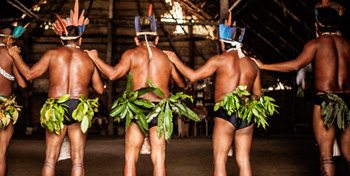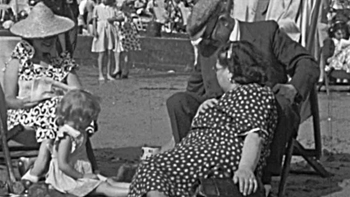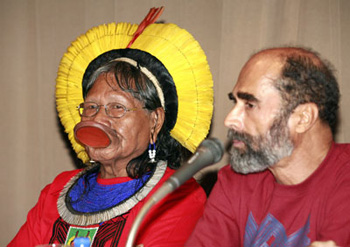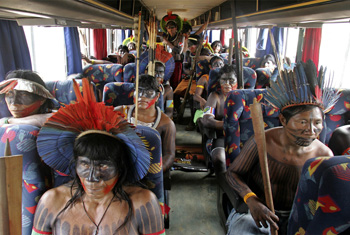The Barbarism of the West Causes Tribalism
Gonzalo Larrain Campbell
A New Mass at Mission San Juan Bautista in California - the new evangelization promotes tribalism
Plinio Corrêa de Oliveira describes the
decadence of the West and predicts the anarchist-tribalist society to
which it would lead. The current propaganda promoting indigenous culture
and cults confirms this prediction.
Not a few people wonder why so many ecclesiastical and civil figures
have come to praise the Indians – in their savage and uncivilized
conditions – giving indigenous peoples a disproportional relevance in
the media and granting small groups of them millions of acres of
territory. The response to this justifiable inquiry has been given by Plinio Corrêa de Oliveira. Already in the 1940s, he was predicting that the religious and moral degradation produced by the revolutionary process, especially in the West, would lead the world to the complete abandonment of civilization and a state of affairs analogous to tribalism.
'They free themselves from civilization'
As such, in 1944, writing about the previous year's carnival (a 3-day annual Brazilian festival before Ash Wednesday similar to Mardi Gras), he affirms:

Brazilian Indians held up for admiration and a model for the Westh...
"We have finally reached this result: Formerly the carnival was a reprieve, liberation. But a liberation presupposes a restraint. But, since life has transformed itself into a carnival; the carnival lost its raison d’être […].
“Today everyone flees to the beaches and to the countryside. For what? To rest? Yes. Only to rest? Maybe not. Indeed, once they have arrived at the beaches or countryside, what do these travelers do? Another liberation. They free themselves from civilization. They strip themselves of everything that can be removed.

Above, a well dressed family at the beach in the 1950s; below, an almost complete nudity at beaches today

"It is the fruit of another kind of liberation. Once the carnival was a liberation of immorality. Today, those who travel to the beaches or countryside liberate themselves from the most elemental rules of civility.
"Thirty years from now, it is likely that this liberation will consist in wearing only a thong, no longer cleaning one’s ears, nose or nails, spitting on the floor and dancing samba barefoot in the jungle. There will be luxury huts, with a daily rate of $300-$400 dollars. Every feather on the thong will cost $50 dollars, which would not be so exorbitant since it would only have a few feathers. A model thong that could boast such originality as having feathers from birds of various countries will cost some $5,000.
"One might say this is an exaggeration. Thirty years ago, there were some ‘Catos’ (1) who predicted the filth we would find ourselves in today. And there were also some permissivists who responded: ‘An exaggeration!’ The prophets were not exaggerators; the exaggerations came in the events that surpassed the prophecies.” (2)
The Fourth Revolution and tribal barbarism
In the third part of Revolution and Counter Revolution written in 1976 – that is, 32 years after the first text – Plinio Corrêa de Oliveira explains in detail the prediction he made in 1944. Analyzing the internal transformation through which the Third Revolution (Communism) passed, he affirms that the dictatorship of the proletariat is not the end of the revolutionary process. (3) And he predicts the birth of the Fourth Revolution [Tribalism].
“It is not impossible, however, to predict what the Fourth Revolution will be like. […]
“This revolution will necessarily be the overthrow of the dictatorship of the proletariat as a result of a new crisis. Pressured by this crisis, the hypertrophic State will be the victim of its own hypertrophy. And it will disappear, giving rise to a new state of affairs that is scientific and cooperative, in which – so the communists say – man will have reached a heretofore inconceivable level of liberty, equality and fraternity.
“How shall this come to pass? It is impossible to not ask if the tribal society dreamed of by current structuralist-tribalist trends provides the answer to this question. Structuralism sees in tribal life an illusory synthesis between the height of individual liberty and a consensual collectivism, in which the latter ends up devouring liberty. In this collectivism, the various “I's” or individual persons, with their intellects, wills and sensibilities, and, consequently, with their characteristic and discrepant ways of being, merge and dissolve into the collective personality of the tribe, which generates one thinking, one will and one way of being intensely common to all.

The tribal tendencies unleashed at Woodstock
“In what way? In tribes, the cohesion among the members is assured mainly by a way of thinking and feeling common to all, from which result common habits and a common will. In the tribes, individual reason is reduced to almost nothing, that is to say, to only the first and most elemental movements allowed by this hypertrophied state – ‘Savage thought,’ (4) a thought that does not think and is turned only to the concrete – this is the price of the tribal collectivist fusion. The sorcerer is responsible for maintaining, on a mystical plane, this collective psychic life by means of totemic cults charged with confusing ‘messages,’ but ‘rich’ in deceptions or even fulgurations emanating from those mysterious worlds of trans-psychology or para-psychology. By acquiring these ‘riches,’ man would compensate for the atrophy of his reason.
“Yes, reason - which was formerly hypertrophied by free interpretation of the Scriptures, Cartesianism and other causes, divinized by the French Revolution, and then utilized to its most exacerbated abuse in every communist school of thought - now finally would be atrophied and enslaved in the service of trans-psychological and para-psychological totemism.” (5).
Prof. Plinio Corrêa de Oliveira goes on to describe the moral decadence befalling the West, with the anarchist- barbarian-tribalist goal of the Revolution:
'Structuralism – Pre-tribal tendencies’
“To the extent that one sees the structuralist movement as a more or less precise - but in any case precursory – figure of the Fourth Revolution, – one must view certain phenomena related to it, which became generalized over the last 10 or 20 years, as preparing for and driving the structuralist impetus.

Casual habits and clothing as the West abandons its culture; more radical elements assume a satanic barbarism

“The rapid disappearance of the rules of courtesy can only end in the absolute simplicity (to use only this qualifier) of tribal manners.
“The growing repugnance for everything that is rational, structured and systemized can only lead, in its last paroxysms, to the perpetual and fanciful vagabondism of jungle life, alternating with the instinctive and almost mechanical execution of certain activities t hat are absolutely indispensable to life.
“The aversion to intellectual effort, especially to abstraction, theorization and doctrinal thought, can only lead, ultimately, to a hypertrophy of the role of the senses and the imagination, resulting in the ‘civilization of the image’ about which Paul VI deemed it necessary to warn mankind”(6)
Confirmation of these predictions
Thus, on the one hand, the Revolution is barbarizing the West, and, on the other, the same Revolution is revealing, by the way of facts, the new human type toward which the world is moving: the native in his most primitive and savage state.

Above, Kaiapo Indian leader being used by the green Left to promote tribalism; below, Indians transported in buses to protest the building of a dam

- Kaiapó Reservation, in the State of Pará, with 7.9 million acres, given to 3,000 natives (Folha de S. Paulo, June 9, 1992);
- 22 reserves with a total of 8.1 million acres, for 9,488 natives (Folha de S. Paulo, May 30,, 1992);
- Menkragnoti Reservation, in south Pará, with 12.1 million acres, for 489 natives (Folha de S. Paulo, July 5, 1992). This reserve will be joined with the Kayapo and Jarina reserves, as well as to the Xingu National Park, forming a total of 27.6 million acres (ibid.);
- Araweté Reservation, in southeast Pará, with 2.4 million acres, for 195 natives (Folha de S. Paulo, April 19, 1992);
- Javari-Juruá Reservation, bordering Peru and Colombia, with 21 million acres, for an unnamed number of natives (Jornal do Brasil,April 21, 2001);
- Baú Reservation, in south Pará, with 3.4 million hectares. The Superior Court of Justice denied the inclusion of 1.1 million more acres. The extension was in a provision of the Ministry of Justice, but was a subject of appeal to the Federal Public Ministry (Folha de S. Paulo, 2-14-01), and the decision is being repealed. The extension will go to the city of Novo Progresso and include countless private estates. Total natives in the reservation: 120 (O Estado de S. Paulo, August 13, 2000);
- The lands reserved for natives now totals 257,899 million acres, more than 620,000 square miles, equivalent to 12.26% of the national territory (A Noticia, Joinville, April 19, 2000). (7)
The solution
Before concluding, we must make clear that Plinio Corrêa de Oliveira had no objections to the indigenous peoples as such, or any other race. To the contrary, he always recognized their authentic values. What he desired - as one can see in his book Indian Tribalism, the Communist-Missionary Ideal for Brazil in the 21st Century, was that the savages should be evangelized and civilized according to the traditional doctrine of the Church, as was done in the past by the Spanish Jesuit Blessed José de Anchieta, Fr. Manuel da Nóbrega and other true men of God.

A Mass at Mission San Juan Bautista in California - the new evangelization promotes tribalism
We conclude these considerations – which to some may seem bleak, but whose origin and timeliness cannot be denied – asking Our Lady Aparecida, Queen and Patroness of Brazil, to have mercy on the savages, who are being manipulated today by revolutionary priests and laymen. We ask her to send authentically counter-revolutionary missionaries so that she may convert them to the one true Religion, transforming them into new disciples of Blessed Anchieta and into valiant defenders of the Catholic Faith, as they were in times past, as for example, the Brazilian Indian Felipe Camarão and those that followed him. (8)
- A reference to Cato, a conservative Roman senator known for his austerity.
- Legionário, n. 603, 2-27-1944, 'Seven Day Review'.
- In fact, 30 years after the publication of the third part of Revolution and Counter-Revolution, many countries are in an advanced process of the dismantling of the State, which shows itself incapable of efficiently exercising its essential functions such as, for example, maintaining public order, administrating justice, preventing or punishing delinquency, controlling prisons, reigning in corruption, defending its sovereignty against subversive or regionalist movements, etc. Examples of these movements are certain NGOs and the swarming guerillas in many countries of Latin America and Africa. What has happened along these lines in Colombia was set out in a previous article. (Translator’s note: This article, not yet been published in English, is in Larrain’s book in Spanish from which we take the present article.)
- Claude Lévy-Strauss, La pensée sauvage (Plon: Paris, 1969).
- Revolution and Counter-Revolution, Part III, Chapter III (1-2), Lima, Peru: Erba Grafica S.A.C., July 2005, pp. 159-161.
- 6. Cf. Apostolic Exhortation Evangelii Nuntiandi, December 8, 1975, Pontifical Documents, n. 188 (Petrópolis: Vozes, 1984), p. 30 in ibid., Chap III, 2-B, pp. 161-162.
- Dominique Pierre Faga, Indios: As Invasões perante o Direito Brasileiro e a Questão Indigenista desde os Seus Primórdios (São Paulo: Diário das Leis Ltda., 2002), pp. 16-17.
- António Filipe Camarão (c. 1580 –1648) was an indigenous Brazilian from the tribe of the Potiguara near the Rio Grande do Norte area. He led an Indian regiment against the Dutch Protestants who tried to take over Brazil.
Fr. Sretenovic "Getting Out of the Novus Ordo"
